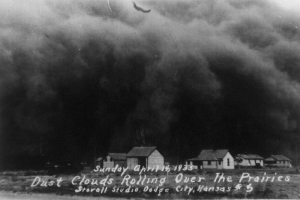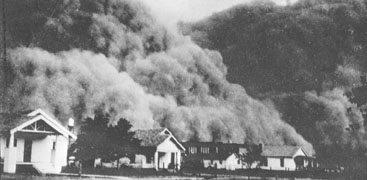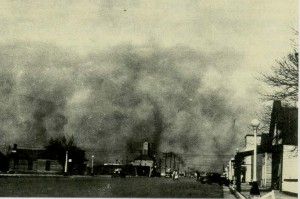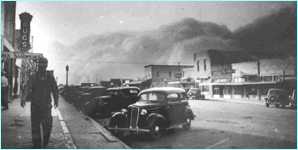Since I’m visiting my family in rural Oklahoma, I decided to post some pictures of dust storms during the 1930s. Almost everyone has seen some of the Dust Bowl-era photos of poor families, of houses covered in blown dirt, and so on, but fewer people have seen photos of actual storms blowing in. All of these are available from Kansas State University’s Wind Erosion Research Unit.
This one is from a storm that was widely considered the worst of all; April 14th, 1935 was referred to as “Black Sunday”:




Most people associate the Dust Bowl with Okies and The Grapes of Wrath. The Joads weren’t Dust Bowl refugees; most Okies were from eastern Oklahoma and lost their farms because they couldn’t pay the mortgages. Only a small part of the Dust Bowl was in Oklahoma, though my great-grandparents and their many children had the good luck to be living in it.
While a bad multi-year drought certainly set the stage for the Dust Bowl, it was really a social disaster, not a natural one. Semi-arid regions had been over-plowed, and no windbreaks were planted to help hold soil in place. And once the dust storms began, many farmers did about the worst thing they could have done: they went and plowed during it. My great-grandpa and his sons would go out with the horses and start plowing as a dust storm came in, hoping they could turn up moister soil from underneath that would be too heavy to blow away. But because of the drought there wasn’t any moist soil to turn up, so all they were doing was breaking up dry dirt, making it even more likely to blow away…and presumably so were thousands of other people. My great-grandma always told me the big joke was that if you had a bucket you could hold it up outside and catch yourself a farm.
Anyway, no huge sociological insight here, just some fascinating and creepy photos and a reminder that things we often refer to as “natural” disasters are either caused by human activity or greatly exacerbated by it.
And I have to drive 30 miles each way to get to the internet, so I’m not able to read comments or add commenter’s interesting links as much as I usually try to do, so be patient for the next couple of weeks.

Comments 9
Anonymous — May 21, 2009
One of the WPA projects in the 1930s was to plant trees and shrubs to create windbreaks, in order to reduce wind erosion of top soil. These plantings also reduced erosion generally, provided cover for wildlife and reduced wind damage to crops. Across much of the midwest, at least, these have been substantially reduced or removed. In many places in Kansas, the remains of these can be seen as a line of scraggly hedgeapples, which now provide minimal protection. Many of these windbreaks have been destroyed in the consolidation of farms, as industrial mega-farms have taken over our food production. The way things are going, I see nothing to prevent a return of these dust storms.
Gabriella — May 21, 2009
For anyone who is interested in the topic, I highly recommend Donald Worter's book "Dust Bowl: The Southern Plains in the 1930s." The 25th anniversary edition came out in 2004. It's a very approachable read, useful for undergrad classrooms, and really drives home the relationship between the spread of industial farming techniques and the environment - a very timely topic!
Lindsay — May 21, 2009
I would just like to note that many of us here in Oklahoma have the internet in our homes (as well as electricity, running water, and HBO) and do not have to drive 30 miles each way to access the outside world. :)
Titanis walleri — May 21, 2009
And now other countries (especially China) seem to be making the same mistakes and having dust storm problems of their own...
Kristen — May 21, 2009
In addition to Donald Worster's book, check on Pamela Riney-Kehrberg's Rooted in Dust. I think I spelled her name right.
There are many more pictures (including some of those you've posted here) over at the Kansas State Historical Society's website: http://www.kansasmemory.org. The originals of many of these photos are housed in their archives.
Titanis: Definitely. I believe Worster makes that same point in the conclusion to his book.
Muriel Minnie Mae — May 22, 2009
I've read in a number of places mono-crop plantings were a large part of the problem for the creation of the Dust Bowl. By planting the same crops yearly, the growing plants use up all the nutrients in the ground. Corn doesn't use the same ground nutrients as tomatoes so by rotating your crops, and rotating the planting location, one saves the ground from being depleted of vital nutrients.
Had farmers been planting a variety of crops in a bunch of places then the Dust Bowl wouldn't have happened. I'm not blaming the farmer here, I'm blaming whomever decided corn, soy, and cotton are the only valuable crops to plant en masse.
waxghost — May 22, 2009
Ha, Lindsay, yes! When I moved here, my relatives on the coast asked me what it was like on the farm! But I am writing this through cable internet from the comfort of my apartment in a city.
We could start a whole new discussion about how people (including myself, before I moved here) think these pictures STILL represent life in Oklahoma, 80 years later.
Lindsay — May 24, 2009
To be sure! I moved here a year ago from Los Angeles, and I first visited three years ago. I was expecting red dirt, republicans, Baptists, and not much more. Even with lots of family in Texas and having grown up visiting them all of the time, I was expecting Oklahoma to be 50 years behind...perhaps not technologically, but socially for sure. I have been pleasantly surprised, to say the least.
Box » Blog Archive » dust storm pictures — June 12, 2011
[...] Dust Storm Photos В» Sociological Images May 21, 2009 … Since I'm visiting my family in rural Oklahoma, I decided to post some pictures of dust storms … [...]